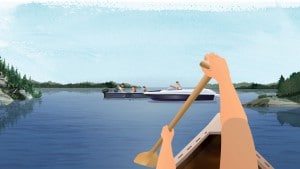Reckless Boat Operation Laws
According to Oregon’s reckless boat operation laws, it is illegal in the state of Oregon to operate a boat in an unsafe or reckless manner that endangers or would be likely to endanger any person or property.
Examples of ‘unsafe’ boat operation include:
- Damaging another boat with the wake of your boat.
- Causing another boat to capsize with the wake of your boat.
‘Reckless’ boat operation is defined as operating a boat carelessly and heedlessly in willful or wanton disregard of the rights, safety or property of others.
Examples of Oregon’s reckless operation violations include:
- Operating at a dangerous rate of speed.
- Boating in a restricted area.
- Jumping the wake of another boat.
Failure to Maintain a Proper Lookout
The operator of a boat must keep a proper lookout at all times while underway. Violation example: A boat operator that is pulling and watching a waterskier, rather than the water ahead, would be in violation of this law.
Especially Hazardous Conditions
If peace officers observe a boat being operated in an especially hazardous condition, they may order the operator to move to the nearest safe moorage and remain there until the condition is remedied. Examples of especially hazardous conditions include:
- Overloading or overpowering.
- Leakage of fuel from the boat engine, fuel system or fuel in the bilge.
- Riding on a motorized boat’s bow, deck or gunwale at a speed exceeding 5 mph, unless the boat has adequate guards or railings (standing on bow decking is allowed for mooring or casting off).
- Improper or insufficient:
- Lifejackets.
- Fire extinguishers.
- Backfire arresting devices on carburetors.
- Navigation lights between sunset and sunrise.
Boat Speed Limits and Operation in Restricted Areas
Speed Limits
It is illegal to operate a boat at a rate of speed greater than that which will permit the operator to exercise reasonable care to bring the boat to a stop within the assured clearing distance ahead.
Boat operators must observe a ‘Slow – No Wake’ (maximum 5 mph speed limit) when within 200 feet of:
- A boat ramp, marina or moorage with a capacity for six or more boats;
- A floating home moorage with six or more structures, or;
- People working at water level.
Operators may be liable for any damage caused by their wake. This rule does not apply to commercial boats or river navigation when more speed is needed to ensure safe passage.
Restricted Areas
Many waterways in Oregon have special boating restriction regulations depending on the type and size of waterway, such as ‘No-Wake’ zones and speed restrictions. All operators should familiarize themselves with the restriction regulations for the body of water on which they plan to navigate.
You can view a list of Oregon’s restricted zones in the Oregon State Boating Legislature.


